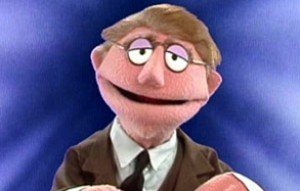The Muppet Show Pitch Reel
And now, after viewing the two failed ABC pilots, we come to Jim Henson’s next attempt to finally bring The Muppet Show to primetime, one which ultimately proved successful but not directly or immediately.
But I’m getting ahead of myself. To tell a long story as succinctly as possible, Jim hired David Lazer–an IBM exec who worked with him on the short films he and the Muppets made for that company and who was extremely enthusiastic about Jim and his talents–as a new producer. Lazer was a much slicker, savvier Hollywood type than the Henson people were generally used to but he knew how to sell things in the entertainment industry. Meanwhile, Jim made an appearance on CBS’ Cher show (unfortunately, I wasn’t able to locate any clips to watch), which also had a major impact. Cher and her producer, George Schlatter–the
Read MoreNBC White Paper Credits
A little later today, we are finally going to explore the origins of one of Jim’s most famous, enduring projects, Sesame Street, but firstly, a brief bit of non-Muppets footage. Earlier in 1968, NBC had been extremely impressed with Jim’s Youth 68 documentary and so hired him to create a credits sequence for a three-part documentary series called Ordeal of the American City, which was itself part of an NBC news series called NBC White Paper. And here is the footage, which follows Jim’s penchant for juxtaposing quick shots to create an overlapping collage effect. Here, the images are all urban in nature, the images being used to underline the fraught tensions underlying city life:
Read More
Muppets for IBM
In 1965, IBM hired Jim Henson to make a number of short “industrial” films for their company, which were effectively intended as comedic shorts to break the tedium of long meetings. Later on, Jim would produce similar short pieces called the Muppet Meeting Films which could be used for any corporate client, and some of which were actually remakes of these early bits for IBM. I wasn’t able to get exact dates for all of these films, and some of them I know are from 1965, so I’ll be jumping backwards in the chronology a bit here, but it seemed like it would make most sense in this case to combine them all in one place.
What is likely the earliest of the set is a 4-part film starring Rowlf in which he writes home to his mom, documenting his first year as a salesdog for
Read MoreRipples, Wheels, Etc.
In 1967, Jim Henson made a one-minute short film for “Expo67,” which was a World’s Fair, in Montreal, Quebec. Called Ripples, it is reminiscent of Time Piece in its use of a stream-of-consciousness series of images that flow emotionally rather than logically, however in a much more compressed format, as well as the Bufferin ad in the previous post in its exploration of the human mind. Over the course of the minute, an architect played by Jon Stone–a producer who collaborated with Jim on a Cinderella pilot in 1965, and would later bring Jim on board to Sesame Street, and even later write The Monster at the End of This Book–drops a lump of sugar into his coffee, causing ripples in the glass, which fades to a shot of him by a lake, tossing pebbles into the water, each ripple bringing up images in his mind of architecture and art, moments of great progress throughout history and the then-modern day/future (illustrated via shots of NASA rockets and mission control centers), his home life, and his family. In a few short moments, it establishes ripples of connection between humanity, human progress and achievement, nature, and us.
Read More
More Short Films
Today, we’re starting off with two more short film projects that, remarkably–given how much work Time Piece was–Jim also did in 1965! The first is called Run, Run, which he shot outside his home in Greenwich, CT. It mainly depicts Jim’s two young daughters running around the fallen-leaf-strewn woods in October and ends with them running into their mom, Jane’s, open arms. I don’t have a great deal to say about it, but it’s a charming little piece, thanks to the score by Joe Raposo, who would later write the songs and music for Sesame Street, and like much of Jim’s short film work, it has a similar feel to the short pieces he’d shoot for Sesame Street of children playing and the like, with similarly gentle, lovely music. It also demonstrates some quietly inventive camera work, with the camera at first following the girls from a distance but eventually capturing their POV, bouncing up and down to recreate what they’re seeing as they dash along:
https://www.youtube.com/watch?v=MeyyOQJKay0
Read More

